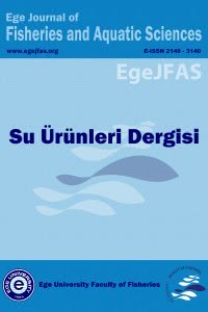Uzatma ağlarının ağ materyali ve yapısal özelliklerinin türlerin yakalanabilirliği ve tür seçiciliği üzerindeki etkisi
balık avlama ekipmanı, seçicilik, balık avlama, av kompozisyonu (balık)
Effect on catchability of species and species selectivity of structure properties and net material of gillnets
fishing gear, selectivity, fishing, catch composition,
___
Aksu, H., 2006. The effect of using sardon in trammel nets on prevent catching of discarded species, (in Turkish). Ondokuz Mayıs University Natural Science Institue, Msc. Thesis, 90 p. Samsun.Anonymus, 2006. Türkiye Statistical Society, Fisheries statistics 2004, (in Turkish).
Balık, İ., 2001. Comparison of sesonal catch per unit efforts for monomultifilament trammel nets in Lake Beyşehir. Turkish Journal of Fisheries and Aquatic Science 1: 17-21 p.
Clucas, I., 1997. A study of the options for utilisation of by-catch and discards from marine capture fisheries, FAO Fish. Cir. No: 928 FIIU/C 928 Food and Agriculture Organisation of the United Nations Rome.
Engas, A., S. Lokkeborg, 1994. Abundance estimation using gillnet and longline. In The Role of Fish Behaviour Marine Fish Behaviour in Capture and Abundance Estimation. Chapter 8, pp.130-163. Ed. By A. Fernö and S. Olsen. Fishing New Boks, London.
Erkoyuncu, İ., 1995. Fisheries biology and population dynamics, (in Turkish). Ondokuz Mayıs University Book, Number: 35, 265 p. Samsun
Fernö, A., S. Olsen, 1994. Marine fish behaviour in capture and abundance estimation. Fishing News Books, 224 p. Published 1994. ISBN 0-85238- 211-1 London.
Godoy, H., D. Furevik, S. Lokkeborg, 2003. Reduced bycatch of red king crab in gillnet fishery for Cod (Gadus morhua) in Northern Norway. Fisheries Research 62: 337-384 pp.
Gökçe, G., 2004. Research on reduction of non-target species in shrimp trammel net, (in Turkish). Ege University Natural Science Institue, Phd Thesis, 115 p. Izmir.
Gurbet, R., A. Alaz, A. Ayaz, M. Erdem, 1998. Research on catch efficiency of gillnets, (in Turkish). E.U. Research Fund Project No: 1996 SUF-01 Project Report.
Hylen, A., T. Jacobsen, 1979. A fishing experiment with multifilament, monofilament and monotwine gillnets. In The Role of Fish Behaviour Marine Fish Behaviour in Capture and Abundance Estimation. . Ed. By A. Fernö and S. Olsen. Fishing New Books, London. Published 1994. ISBN 0-85238-211-1
Millner, R.S., 1985. The use of anchored gill and tangle nets in the sea fisheries of England and Wales. Laboratory Leaflet No:57 Lowesoft.
Özdemir, S., Y. Erdem, 2006. The comparasion of catch efficiency of mono and multifilament gillnets on different weather conditions, (in Turkish). Science and Engineering Journal of Fırat University, 18(1): 63-68 p. Elazığ.
Özdemir, S., Ç. Sümer, Y. Erdem, 2003. Comparison of catch compositon and catch efficiency of trammel nets which have different material, (in Turkish). XII. National Fisheries Symposium, Announcements Book, 467- 472 pp. Elazığ-Türkiye.
Potter, E.C.E., M.G. Pawson, 1991. Gill netting. Ministry of Agriculture, Fisheries and Food Directorate of Fisheries Research, Laboratory Leaflet, Number 69: 1-35 p.
Rudstam, L.G., J.J. Magnuson, W.M. Tonn, 1984. Size selectivity of passive fishing gear: A corection for encounter probability applied to gillnets. Can. J. Fish. Aquat. Sci. 41:1252-1255 p.
- ISSN: 1300-1590
- Yayın Aralığı: 4
- Başlangıç: 1984
- Yayıncı: Aynur Lök
Cladocera and Copepoda (Crustacea) fauna of Çatalan Dam Lake (Adana, Turkey)
Ahmet Turan ALADAĞ, Cahit ERDEM, Süphan KARAYTUG
Comparision of Two thiobarbituric acid (TBA) method for monitoring Iipid oxidation in fish
BAHAR TOKUR, KORAY KORKMAZ, DENİZ AYAS
Tilapia culture and its problems in Turkey
Tülay ALTUN, Nazmi TEKELİOĞLU, DURALİ DANABAŞ
Güneydoğu Marmara'da algarna ile karides avcılığında av kopozisyonu ve hedef dışı av
YUSUF KENAN BAYHAN, ERDOĞAN ÇİÇEK, Tarık ÜNLÜER, Mehmet AKKAYA
Rotifera fauna of Yamansız Lake (Antalya) in south-west of Turkey
U. Tansel ŞİRELİ, Muammer GÜNCÜOĞLU, YELİZ YILDIRIM, ALİ GÜCÜKOĞLU, Ömer ÇAKMAK
Miliç Irmağı (Terme, Samsun) balık faunası
Kafes işletmeciliğinde orkinos (Thunnus thynnus L., 1758) sağlığını olumsuz etkileyen faktörler
